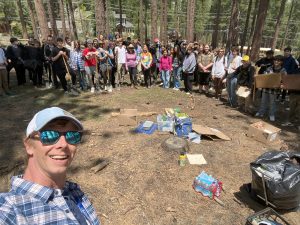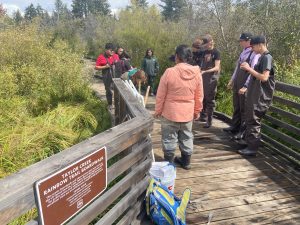
South Tahoe High School “Tahoe Science” K12
While Lake Tahoe’s waters are hailed as one of the purest in the world, that clarity has been steadily decreasing, partly due to its staggering 15 million annual visitors. That’s why local high school students are wading in to keep Tahoe blue as they cultivate greener careers.
“I’m helping out my community and learning something at the same time,” says South Tahoe High School junior Sayers Tanner. Every Thursday, his Tahoe Science class tests the water quality from Kiva Beach and the Truckee River. Their data is helping the environmental research organization The Great Basin Institute and the US Forest Service control invasive aquatic plants.
“It’s basically a mini field trip in one hour,” says Tanner, who puts on fishing waders, stands among the spawning salmon, and takes samples to collect vital data. At the end of the semester, students will present their findings to the Forest Service to help keep the aquatic weeds out of the water.
“Getting an opportunity to do field research as a high schooler is pretty unique,” says industry partner Cameron Meikle, Education Coordinator for The Great Basin Institute. He says Tahoe Science instructor Richard Kinnett encourages students to consider high-demand careers in natural resource management.
“Richard’s class tends to be low-income or potentially at-risk students, so getting them involved is important … to deal with the problems that are challenging their community,” says Meikle.
In its second year, the new Tahoe Science Pathway, based on California CTE forestry and natural resource standards, makes science increasingly accessible to historically underrepresented learners.
“While AP Environmental Science was primarily created for four-year college-bound students, we created the Tahoe Science Pathway to specifically recruit students who ‘think’ they struggle with science and have not really experienced the treasures and careers that Lake Tahoe has to offer,” explains Kinnett.
As a Title One designated institution serving low-income students, the high school realized that previously, learners weren’t signing up for elective sciences, which limited their college and career options. Plus, these students didn’t have the resources to enjoy Tahoe’s world-famous skiing, mountain biking, and paddle boarding. By combining recreation with real-world science, the school is making both attainable while encouraging learners to become the region’s future conservationists.
“Our local agencies don’t need people with biology degrees; they need people with certificate training and some educational background,” says Isaiah Tannaci, Lake Tahoe Unified School District CTE Coordinator, who hopes to bolster the local talent pipeline.
The US Forest Service, CAL FIRE, and conservation nonprofits regularly visit classes and collaborate on hands-on projects, encouraging students to join the field. Kinnett also works with SOS Outreach, a nonprofit that teaches underprivileged youth skiing and snowboarding. The organization offered a resume-building and interview day, connecting multiple students to summer work opportunities in the industry.
The first Tahoe Science class debuted last spring with 90 sophomores, and this year, the school is running the first iteration of the second class in the pathway. The lessons apply science concepts through the lens of Lake Tahoe, integrating resource management, forestry, fire science, and more.
“We are pioneering a pathway,” says Kinnett. In addition to water and soil quality testing, students apply Newton’s physics laws to mountain biking and skiing and explore electromagnetic resonance using transceivers in mock avalanche rescues. This semester, Tahoe Science Two cadets competed in the El Dorado Forestry Challenge, demonstrating ecology and resource management know-how by taking stock of forest plots.
“We went out there and collected a lot of data,” recalls Tanner. “At the end, we presented how we could improve the forest through many different treatments, whether that be prescribed fires, cut and burn, or masticating.”
Making science accessible would not have been possible without the Strong Workforce Program, which helped develop the curriculum, purchase necessary recreational equipment, and support salaries for the instructor and field trip assistant. The funds also helped the district overcome a bus driver shortage by providing vans for the weekly field trips.
“So much of public education is small, slow, incremental change,” Tannaci says. “Having a big shot in the arm through Strong Workforce to fully build the program was a great opportunity.”
The school plans to add valuable industry certifications students could earn while still in high school, including CPR. Future possibilities include Leave No Trace, fire suppression, and AIARE Level 1 avalanche safety certifications. Additionally, the school is developing dual enrollment opportunities with Lake Tahoe Community College.
“The goal is to implement dual enrollment by next year,” says LTCC Director of Forestry, Fire, and Public Safety Adrian Escobedo.
The community college just started a new certificate in forestry last year, an exciting next step for Kinnett’s budding natural resource management students. LTCC is also creating unique ESL support for its forestry program, providing class materials in students’ native languages. Since the Tahoe Science classes are about 80 percent Latinx students, many of whom speak English as a second language, the extra support is on point. “We’re one of the first to do something like this,” says Escobedo. “We hope the high school students see that this material will be available so they can say, ‘I can do these classes.’”
Escobedo says he’s pleased to be a part of the pathway that makes science and natural resources more available to underrepresented learners.
“I applaud Isaiah, Richard, and the whole team over there for their work,” says Escobedo. “Students are learning how science affects the environment and their own community, making their studies relatable, so the kids are excited to learn.”
 The growing interest in natural resource management is timely, as high-demand, high-paying careers in the field are increasing.
The growing interest in natural resource management is timely, as high-demand, high-paying careers in the field are increasing.
“Our local partners in the federal sector are already advertising positions to our students,” says Escobedo. “We’re trying to provide as much training as possible to provide good employees for all our partners.”
As a high school junior, Tanner is already charting his career path, with plans to start at LTCC and transfer to the University of California, Davis, to study allied health. The student says his Tahoe Science classes have opened up new possibilities: “I’ve always planned to go into the medical field, but there are a lot of medical people in forestry.”
Now, Tanner is exploring seasonal work surveying stands of trees, just as he did for the El Dorado Forestry Challenge, or even trying wildland firefighting.
He says, “One way to avoid student loan debt is to work while in college, and my Tahoe Science class will allow me to get really good jobs that pay a good amount.”
His professor couldn’t be prouder and is excited that the new science pathway is helping learners like Tanner blossom:
“Sayers is an extremely intelligent student who, at times, has struggled with his traditional classes, but he has found an area to thrive when learning about forestry and natural resources connected to Lake Tahoe.”
November 2023